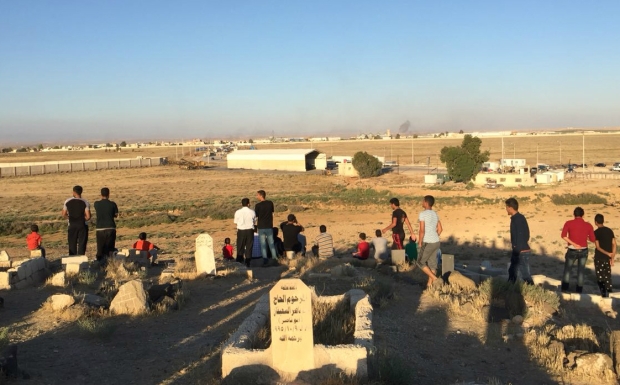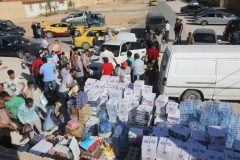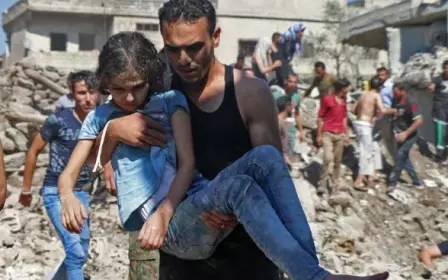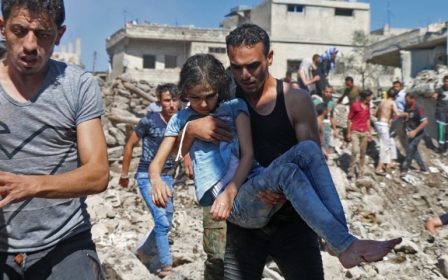'We know suffering': Refugees and Jordanians come to aid of displaced Syrians
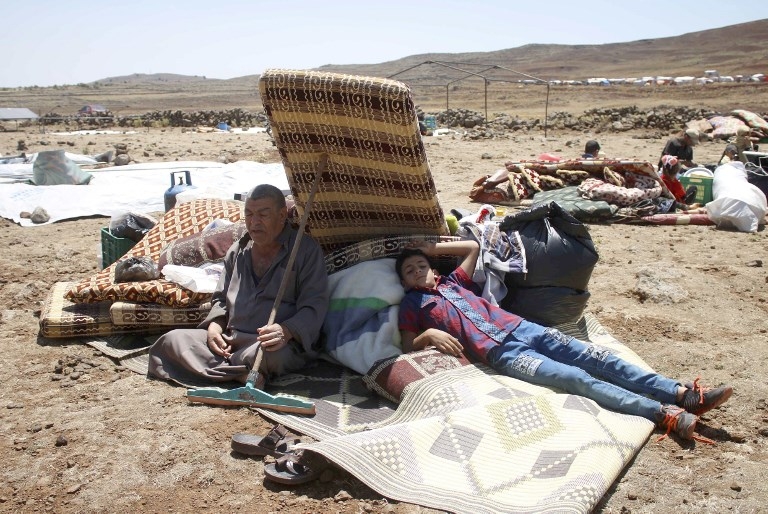
“From the home of the dead, we are watching the dying,” said Nader Daoud, one of several Jordanians and Syrian refugees standing in the Turaa cemetery on Tuesday in the city of Ramtha near the border with Syria.
Our children will give up their clothes for them, they understand the depth of the human suffering of their Syrian brethren
- Amin Tobasi, volunteer
From their vantage point, the onlookers in Jordan could see plumes of smoke in the distance, as the Syrian city of Daraa and its surroundings - which have been the site of fierce fighting since mid-June - stood a mere seven kilometres away.
But Daoud and the others were not merely gathered to be spectators to the violence - they were also observing as trucks filled with humanitarian aid they had helped collect entered Syria.
The United Nations estimates that between 270,000 and 330,000 people have been displaced in southern Syria since 19 June, many of whom have been left without shelter in the sweltering heat, vulnerable to deadly scorpions and snakes.
Some Jordanians have taken up the slogan "open the borders" to urge the government to reverse its decision to deny refugees entry to the country.
But with no sign of that happening, and as the number of internally displaced Syrians along the border with Jordan and the Israeli-occupied Golan Heights grows, Jordanians from across the country launched a campaign to collect humanitarian aid to send to Syria.
Grassroots campaign
The grassroots campaign began on 1 July, initiated by a number of activists on social media in response to the Jordanian authorities' stance.
Amjad Thiabat, a car mechanic in Ramtha, put out a video by Facebook calling on people to contribute that quickly went viral, and soon contributions began pouring in from across the country.
"We are opposed to closing the border,” Thiabat told MEE. “But if the government insists on closing the border and it has security concerns, we will send them relief.
"Children have contributed their toys, others gave up the money in their piggy banks," said Amin Tobasi, a volunteer from the Palestinian refugee camp of al-Husn.
An imam in al-Husn, Tobasi helped coordinate the collection of 12 small trucks’ worth of bottled water, nappies, bread, canned food, biscuits, clothes and blankets.
People in this Palestinian refugee camp know what it means to be in want, and they realise the depth of the crisis in Syria
- Amin Tobasi, volunteer
"Despite the extreme poverty in the camp we were surprised by the size of the support," Tobasi told MEE. "But people in this Palestinian refugee camp know what it means to be in want, and they realise the depth of the crisis in Syria.
“If Arab governments have abandoned the people of Syria, we have not," he added. "Our children will give up their clothes for them, they understand the depth of the human suffering of their Syrian brethren.”
The generosity of the public has produced dozens of trucks’ worth of food, medicine and other goods, Thiabat told MEE.
Contributions have converged in a public area of Ramtha known locally as Hajj Square.
"We are still collecting food items and badly needed medicine, as well as water,” he told MEE. “The number of displaced people is large and growing every day.”
Governmental assistance
By the second day of the popular campaign to collect aid for Syrians trapped behind the dirt berms at the border, the Jordanian government had joined the campaign and put the semi-governmental Jordan Hashemite Charity Organisation (JHCO) in charge of collecting the contributions and getting them to those in need in Syria by way of the Jordanian army.
After being collected by volunteers in Ramtha, the donations are transferred to JHCO warehouses, after which the organisation loads them onto Syrian-plated trucks that cross the usually shuttered Ramtha and Nassib border crossings with Jordanian army escorts.
Once in Syria, the aid is handed over to local tribes, who then distribute it to the displaced people.
"It is good to receive the government's help through the JHCO to collect funds, because the government has the ability to send aid outside the border. But the process of sending aid is very slow," Thiabat said.
At least five trucks have had to backtrack into Jordan due to fighting, according to JHCO head Ayman Mefleh.
The biggest challenge that delays the delivery of humanitarian aid to displaced Syrians is the absence of any organised group that can distribute these products
- Ayman Mefleh, head of the JHCO
"The biggest challenge that delays the delivery of humanitarian aid to displaced Syrians is the absence of any organised group that can distribute these products,” Mefleh told MEE. “We are working on creating a more organised system to improve our delivery of humanitarian products."
Jordanian government spokeswoman Jumana Ghunaimat said that it aimed to have three safe corridors inside Syria to bring the aid to those in need.
Thiabat said despite the participation of the Jordanian authorities in the relief efforts, calls to open the border crossings would continue, as he appeared to doubt the government’s motivations.
"The government’s role is to participate in collecting and sending aid to improve its image locally and internationally after closing the border in refugees' faces," he said.
“But at the very least, the government should let women, children and the elderly enter, given that they are the vulnerable groups, who cannot sleep out in the open in the heat under the sun."
Middle East Eye propose une couverture et une analyse indépendantes et incomparables du Moyen-Orient, de l’Afrique du Nord et d’autres régions du monde. Pour en savoir plus sur la reprise de ce contenu et les frais qui s’appliquent, veuillez remplir ce formulaire [en anglais]. Pour en savoir plus sur MEE, cliquez ici [en anglais].


